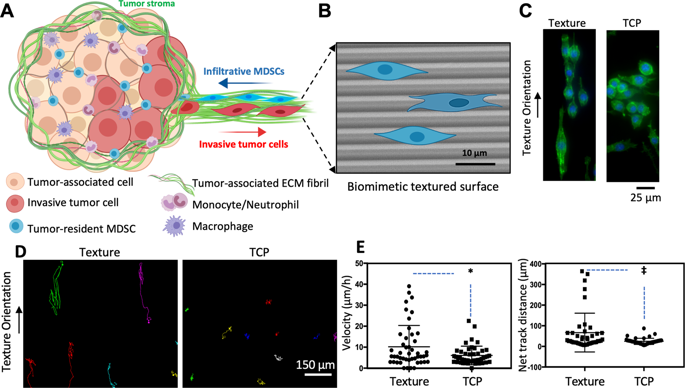Our official English website, www.x-mol.net, welcomes your feedback! (Note: you will need to create a separate account there.)
Guided migration analyses at the single-clone level uncover cellular targets of interest in tumor-associated myeloid-derived suppressor cell populations.
Scientific Reports ( IF 4.6 ) Pub Date : 2020-01-27 , DOI: 10.1038/s41598-020-57941-8 Silvia Duarte-Sanmiguel 1, 2 , Vasudha Shukla 1 , Brooke Benner 3 , Jordan Moore 1 , Luke Lemmerman 1 , William Lawrence 3 , Ana Panic 1 , Shipeng Wang 1 , Nicholas Idzkowski 4 , Gina Guio-Vega 1, 5 , Natalia Higuita-Castro 1, 4 , Samir Ghadiali 1 , William E Carson 4 , Daniel Gallego-Perez 1, 4
Scientific Reports ( IF 4.6 ) Pub Date : 2020-01-27 , DOI: 10.1038/s41598-020-57941-8 Silvia Duarte-Sanmiguel 1, 2 , Vasudha Shukla 1 , Brooke Benner 3 , Jordan Moore 1 , Luke Lemmerman 1 , William Lawrence 3 , Ana Panic 1 , Shipeng Wang 1 , Nicholas Idzkowski 4 , Gina Guio-Vega 1, 5 , Natalia Higuita-Castro 1, 4 , Samir Ghadiali 1 , William E Carson 4 , Daniel Gallego-Perez 1, 4
Affiliation

|
Myeloid-derived suppressor cells (MDSCs) are immune cells that exert immunosuppression within the tumor, protecting cancer cells from the host's immune system and/or exogenous immunotherapies. While current research has been mostly focused in countering MDSC-driven immunosuppression, little is known about the mechanisms by which MDSCs disseminate/infiltrate cancerous tissue. This study looks into the use of microtextured surfaces, coupled with in vitro and in vivo cellular and molecular analysis tools, to videoscopically evaluate the dissemination patterns of MDSCs under structurally guided migration, at the single-cell level. MDSCs exhibited topographically driven migration, showing significant intra- and inter-population differences in motility, with velocities reaching ~40 μm h-1. Downstream analyses coupled with single-cell migration uncovered the presence of specific MDSC subpopulations with different degrees of tumor-infiltrating and anti-inflammatory capabilities. Granulocytic MDSCs showed a ~≥3-fold increase in maximum dissemination velocities and traveled distances, and a ~10-fold difference in the expression of pro- and anti-inflammatory markers. Prolonged culture also revealed that purified subpopulations of MDSCs exhibit remarkable plasticity, with homogeneous/sorted subpopulations giving rise to heterogenous cultures that represented the entire hierarchy of MDSC phenotypes within 7 days. These studies point towards the granulocytic subtype as a potential cellular target of interest given their superior dissemination ability and enhanced anti-inflammatory activity.
中文翻译:

单克隆水平的引导迁移分析揭示了肿瘤相关髓源性抑制细胞群中感兴趣的细胞靶标。
髓源性抑制细胞 (MDSCs) 是在肿瘤内发挥免疫抑制作用的免疫细胞,保护癌细胞免受宿主免疫系统和/或外源性免疫疗法的影响。虽然目前的研究主要集中在对抗 MDSC 驱动的免疫抑制,但对 MDSC 传播/浸润癌组织的机制知之甚少。本研究着眼于使用微纹理表面,结合体外和体内细胞和分子分析工具,在单细胞水平上以视频方式评估 MDSCs 在结构引导迁移下的传播模式。MDSC 表现出地形驱动的迁移,显示出显着的种群内和种群间运动差异,速度达到 ~40 μm h-1。下游分析与单细胞迁移相结合,揭示了具有不同程度肿瘤浸润和抗炎能力的特定 MDSC 亚群的存在。粒细胞 MDSC 的最大传播速度和行进距离增加了约 3 倍,促炎和抗炎标记物的表达存在约 10 倍的差异。长期培养还表明,纯化的 MDSCs 亚群表现出显着的可塑性,同质/分拣的亚群在 7 天内产生代表整个 MDSC 表型层次结构的异质培养物。鉴于粒细胞亚型具有卓越的传播能力和增强的抗炎活性,这些研究将其作为潜在的细胞靶点。
更新日期:2020-01-27
中文翻译:

单克隆水平的引导迁移分析揭示了肿瘤相关髓源性抑制细胞群中感兴趣的细胞靶标。
髓源性抑制细胞 (MDSCs) 是在肿瘤内发挥免疫抑制作用的免疫细胞,保护癌细胞免受宿主免疫系统和/或外源性免疫疗法的影响。虽然目前的研究主要集中在对抗 MDSC 驱动的免疫抑制,但对 MDSC 传播/浸润癌组织的机制知之甚少。本研究着眼于使用微纹理表面,结合体外和体内细胞和分子分析工具,在单细胞水平上以视频方式评估 MDSCs 在结构引导迁移下的传播模式。MDSC 表现出地形驱动的迁移,显示出显着的种群内和种群间运动差异,速度达到 ~40 μm h-1。下游分析与单细胞迁移相结合,揭示了具有不同程度肿瘤浸润和抗炎能力的特定 MDSC 亚群的存在。粒细胞 MDSC 的最大传播速度和行进距离增加了约 3 倍,促炎和抗炎标记物的表达存在约 10 倍的差异。长期培养还表明,纯化的 MDSCs 亚群表现出显着的可塑性,同质/分拣的亚群在 7 天内产生代表整个 MDSC 表型层次结构的异质培养物。鉴于粒细胞亚型具有卓越的传播能力和增强的抗炎活性,这些研究将其作为潜在的细胞靶点。


























 京公网安备 11010802027423号
京公网安备 11010802027423号